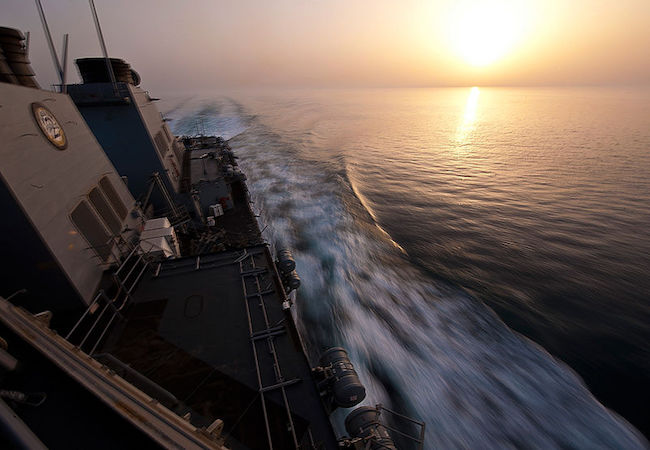
By Richard E. Caroll
With the advances in missile technology deployed close to or on the Chinese mainland’s coast, it is becoming more and more dangerous to have the US super carriers enter these enclosed waters. With US super carriers becoming more vulnerable to the Chinese long-range missile the Dong-Feng 21 (DF-21), a substitute needs to be found that can come close to the Chinese coast, evade detection by Chinese defense networks and be able to deliver a powerful and destructive blow to Chinese defenses. While the DF-21 has its limitations, it is only able to fire its missiles from a hardened prepared position, takes time to set up the erector, and is limited to a hard road and is vulnerable to US counter measures, it is a credible threat to the multi-billion dollar aircraft carriers the US Navy is currently deploying to the tense geopolitical scene in the South China Sea.
The US Navy is experimenting with the concept of a Lightening carrier. The US Navy is taking the America class Amphib troop carriers and converting them into light carriers capable of carrying 13 F-35s each. But even making the aircraft carrier smaller and more maneuverable, it is still visible to satellites and other defensive detection systems.
To be able to deliver a fast, surprise and devastating first strike against the Chinese A2/AD system, a new weapon needs to be brought into the US Navy arsenal, which will be able to operate stealthily, and have a high chance of survival after it delivers its first blow. An Underwater Aircraft Carrier might be the weapon system that the US Navy needs.
World War Two Submarine Cruisers and Aircraft Carriers
During World War Two, there were two classes of combatant ships were made into underwater warships. The French had an underwater submarine cruiser, the Surcouf. Designed to evade certain aspects of the Washington Naval Treaty of 1922, the Surcouf’s primary mission was to maintain contact with France and her colonies over the sea. While the Surcouf was supposed to be the lead vessel in several underwater cruisers, her poor performance brought the class to a halt. There is controversy as to the end of the Surcouf, it is supposed that she sank after colliding with an American freighter by the name of the Thompson Lykes on February 18, 1942.
The Japanese Navy towards the end of World War Two began deploying the I-400 class submarines. The I-400 series were capable of traveling one and a half times around the world without having to refuel. She carried three Aichi M6A1 aircraft, as well as torpedo tubes and deck mounted guns. She carried enough food for her crew for four months. While 18 I-400 class submarines were planned, only three were built and deployed. No I-400 series class submarines were ever engaged in combat.
The AN-1 Underwater Aircraft Carrier
During the 1950’s, the US Navy considered building a new type of aircraft carrier. Designated the AN-1, the concept for an underwater aircraft carrier was studied. The carrier would have used a modified version of the Halibut class submarine design. The AN-1 class submarine would have carried 8 jet aircraft capable of Mach-3, and be capable of carrying a nuclear bomb. Its planes could also have been used to attack land-based targets with conventional weapons, and attack enemy aircraft. The proposed submarine would have been powered by a nuclear power plant, giving it an unlimited cruising range, hobbled only by the needs of its crew for food and fresh water.
The AN-1’s fighter aircraft would have been launched from an upright erector, and would have had to land on the erector backwards. The difficulty of landing an aircraft on its tail proved to be too much a challenge for the fighter pilots. In tests it was incredibly difficult and complicated for the pilot to land the jet fighter by looking over their shoulders.
With the advent of the Vertical Take Off and Landing (VTOL) aircraft, this problem has been solved.
Any Underwater Aircraft Carrier (UAC) would have to be much bigger than the AN-1 was supposed to be due to the nature of todays manned VTOL aircraft. The UAC would need to carry at a minimum eight combat aircraft in order for it to have enough firepower to be successful. The manned aircraft could be supplemented by unmanned drones capable of flying low enough and far enough to carry a strike package that would be able to do a maximum amount of damage to its intended targets. The unmanned drones could also be used as decoys, providing enemy air defense systems with a false picture of intent, while the real threat flew under the enemy’s air defenses radar screens. It would also be imperative that the aircraft launched from a UAC be of a stealthy design so as to protect the location of the UAC and enable the strike aircraft to successfully penetrate the enemy’s air defense systems, and destroy their targets. Once the strike aircraft had struck their targets, they would then head for a rendezvous point with the UAC. The strike aircraft would have to be able to carry nuclear and conventional weapons. The UAC aircraft could also be used as air superiority fighters, to dominate the air space in order for other strike aircraft to deliver a heavier air bombardment.
With the UAC being primarily designed for offensive operations, it would need an escort of at least one, or two, escorting attack submarines. The UAC should be designed as a stealthy underwater platform, but with the cost of constructing such a weapons system, it would be foolish not to provide such a valuable combat strike platform with some security.
The technology to build such a weapons platform exists today. With the increasing aggressiveness of the People’s Republic of China (PRC), and its apparent determination to achieve Hegemon status in South East Asia, a UAC would tip the balance of power in favor of the United States, and force the PRC to devote more resources in combatting this new threat. A UAC would give the US Navy the ability to destroy the A2.AD capabilities of the PLA in protecting their missile sites and their missiles. By being able to destroy the PRC’s A2/AD system, the coast of China would be vulnerable to attack from aircraft from the US Navy’s fleet carriers and from the Lightening carriers being planned.
Richard E. Caroll is a retired economist and soldier.




